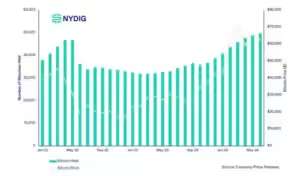Bitcoin Pulls Back After Reaching $72K, but Fed, U.S. Data, and Global Rate Cuts Could Trigger New Highs

Quicktake
- Bitcoin’s recent rally to nearly $72,000 was followed by a pullback, with prices stabilizing around $70,600.
- Upcoming U.S. economic data releases, including the consumer price index and labor market figures, could influence Bitcoin’s next move.
- Market dynamics include significant spot selling and a buildup of short derivatives positions around the $72,000 level.
- Soft U.S. economic data and global rate cuts, including a recent cut by the European Central
Bitcoin Pulls Back After Reaching $72K, but Fed, U.S. Data, and Global Rate Cuts Could Trigger New Highs
Bitcoin experienced a volatile trading session recently, with prices reaching close to $72,000 before pulling back. The cryptocurrency’s price action has attracted significant attention as market participants closely watch for upcoming U.S. economic data releases and central bank actions that could impact future price movements.
On Thursday, Bitcoin (BTC) surged to $71,700, driven by the European Central Bank’s (ECB) decision to cut interest rates. However, this rally was short-lived, as BTC quickly retreated, nearly dipping below $70,000 before recovering to around $70,600 at press time. This represents a decline of approximately 1% over the past 24 hours, according to CoinDesk’s Bitcoin index data.
One of the primary factors contributing to the recent price fluctuation is the spot selling activity observed on major cryptocurrency exchanges like Binance and Coinbase. Notable market analyst Skew highlighted that concerted spot selling, coupled with a buildup of short perpetual futures positions on derivatives marketplaces, has exerted downward pressure on Bitcoin’s price. This activity around the $72,000 level suggests that traders are positioning for potential price declines, which adds to the market’s volatility.
Data from CoinGlass indicates a significant leverage buildup around the $70,000 and $72,000 price areas. This leverage could be subject to liquidation if Bitcoin breaks out of its current narrow trading range, potentially leading to sharp price movements in either direction.
Looking ahead, several key economic indicators are set to be released in the coming days, which could play a crucial role in determining Bitcoin’s next move. The consumer price index (CPI) and labor market data are particularly important, as they provide insights into the state of the U.S. economy. Soft economic data could foreshadow a more dovish stance from the Federal Reserve at its upcoming meeting, which may be bullish for Bitcoin.
The broader macroeconomic environment also supports the potential for further Bitcoin gains. The recent rate cut by the ECB is part of a global trend of easing monetary policy, aimed at stimulating economic growth amid ongoing challenges. If other central banks follow suit with additional rate cuts, this could create a more favorable environment for risk assets like Bitcoin.
Historically, Bitcoin has responded positively to periods of monetary easing and low-interest rates. The influx of liquidity and reduced cost of borrowing can drive investors towards alternative assets, including cryptocurrencies, as they seek higher returns. Therefore, a dovish Fed meeting, combined with global rate cuts, could act as a catalyst for Bitcoin to reach new all-time highs.
While the current market dynamics present challenges, they also offer opportunities. Traders and investors need to stay vigilant and closely monitor economic data releases and central bank actions. These factors will provide critical clues about the future direction of monetary policy and its impact on financial markets, including Bitcoin.
In the immediate term, the upcoming U.S. CPI and labor market reports are likely to be the focal points for market participants. If these reports indicate weakening economic conditions, it could increase the likelihood of a dovish stance from the Federal Reserve, which may provide a boost to Bitcoin prices. Conversely, stronger-than-expected economic data could lead to concerns about continued tightening, potentially weighing on BTC.
The current trading range between $70,000 and $72,000 is a critical zone for Bitcoin. Breaking above this range could pave the way for a renewed rally, potentially targeting new all-time highs. On the other hand, a breakdown below this range might trigger further declines, especially if leveraged positions are liquidated.
Investors should also consider the broader market sentiment and external factors that could influence Bitcoin’s price. Geopolitical developments, regulatory changes, and technological advancements in the cryptocurrency space are all variables that can impact market dynamics.
In conclusion, Bitcoin’s recent attempt to break past $72,000 and subsequent pullback reflect the complex interplay of market forces at work. The upcoming U.S. economic data releases and global central bank actions will be pivotal in determining Bitcoin’s next move. As traders navigate this landscape, they must stay informed and be prepared for potential volatility. With the right conditions, Bitcoin could still achieve new all-time highs, driven by favorable macroeconomic trends and strategic positioning within the market.



